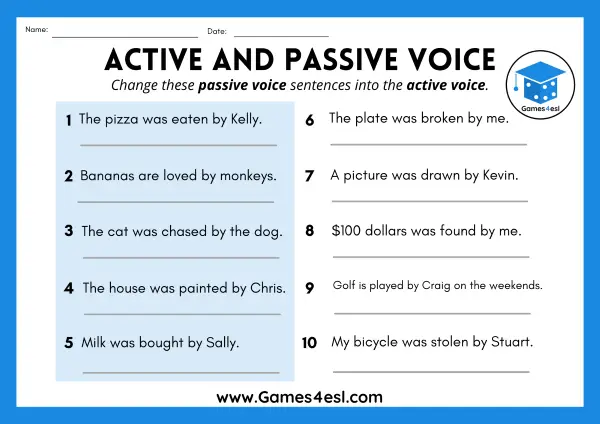Teach The Passive Voice In 8 Easy Steps
Although we are often taught to write in the active voice, native English speakers use the passive voice very frequently in both spoken and written language. For this reason, it is important to teach English language learners the difference between the active and passive voice and how to construct passive voice sentences. Teaching the passive voice can be difficult, but it doesn’t have to be. Follow these 8 easy steps to teach the passive voice and your students will easily understand how to use this grammar structure.
Related: Active Or Passive Voice Quiz
How To Teach The Passive Voice: 8 Easy Steps
Step 1: Demonstrate The Active Voice
You cannot teach the passive voice without first teaching the active voice. So, start with some examples of sentences that use the active voice:
- Erika loves hamsters.
- Pirates discover treasure.
- The clerk counted the money.
Draw students’ attention to what’s happening in these active voice sentences. Each of these sentences follows an active voice structure: subject, verb, and object. In these active voice sentences, the subject is the ‘doer’ of the verb (Erika loves, pirates discover, and the clerk counts). The subjects of these active voice sentences are the ones doing the action. In the active voice, subjects do the action.
Step 2: Explain The Passive Voice Structure
Now that you have broken down the structure of the active voice, it’s time to introduce the passive voice structure. The structure of the passive voice looks like this:
Object + form of to be + past participle + by + subject
Just writing this passive voice structure on the board will probably be quite confusing to students, so use one of the active voice sentences from earlier, and write the passive form of the sentence on the board. For example, “Erika loves hamsters.” would become “Erika is loved by hamsters.”
With this example sentence written on the board along with the passive sentence structure, you can now show students how each word of the sentence corresponds to the passive form structure (i.e. Erika=object, is=to be verb, loved=past participle, and hamsters=subject). Once you have demonstrated the basic passive voice construction, it’s time to go into more detail about the different forms of the verb ‘to be’ and what the past participle is.
Step 3: Review ‘To Be’ And The Past Participle
Before you begin making sentences in the passive voice, make sure all students are on the same page about forms of “to be” and past participles. The forms of “to be” are: am, is, are, was, were, being, been. Next, review past participles. Past participles are verb forms that typically end in -ed. We use past participles to talk about things that have happened in the past. Once your students have these elements down, you are ready to start building sentences in the passive voice.
Step 4: Swap The Subject And Object Of An Active Voice Sentence
Take one of the sentences you used to demonstrate the active voice and ask your students first to identify the subject and the object. If you use the sentence “Erika loves hamsters” they should identify Erika as the subject and hamsters as the object. When you swap the subject and the object, the sentence will look like this: “Hamsters loves Erika”. This sentence is obviously not correct, so next students need to change the verb.
Step 5: Change The Verb Into The Past Participle
Next, ask your students to take the verb “loves” and change it to its past participle form. They should provide the form “loved.” Your sentence now looks like this: “Hamsters loved Erika.” Now the sentences is getting more complete, but we’re not there yet. Next, students have to add ‘to be’ and ‘by’.
Step 6: Add ‘to be’ and ‘by’
Ask your students to look at the passive voice structure that you wrote on the board earlier. Ask them to identify what’s missing from the sentence “Hamsters loved Erika.” They should be able to see that the sentence is missing the ‘be verb’ and the word ‘by’. Ask students where these fit into the sentence and together you should be able to construct the passive voice sentence “Hamsters are loved by Erika.”
Step 7: Check The Structure
Next, check your final sentence to make sure it matches the passive voice structure. Ask the students to identify the parts of the sentence. You can ask, “What’s the object?”, “What’s the subject?”, “Are they in the proper place?”, “Which form of “to be” is being used?”, etc.
Step 8: Have Students Create Their Own Sentences
Now that you have successfully taught your students how to turn the active voice into the passive voice, it’s time to have your students write their own passive voice sentences. A great exercise to practice making passive voice sentences is to provide students with many active voice sentences and have them change them into the passive voice. To help you out, below you can find many examples of active and passive voice sentences.
Active And Passive Voice Examples
If you’re teaching the passive voice these active and passive voice examples will certainly come in handy. Below you’ll find a list of active voice sentences followed by a list of passive voice examples. You can also download these examples as a printable PDF and distribute them in class.
Active Voice Examples
- Kelly ate the pizza.
- Monkeys love bananas.
- The dog chased the cat.
- Chris painted the whole house.
- Sally bought milk.
- I broke the plate.
- Kevin drew a picture of a mouse.
- The waiter always recomends delicious food.
- Craig plays golf on weekends.
- Stuart stole my bicycle.
Passive Voice Examples
- The pizza was eaten by Kelly.
- Bananas are loved by monkeys.
- The cat was chased by the dog.
- The whole house was painted by Chris.
- Milk was bought by Sally.
- IThe plate was broken by me.
- A picture of a mouse was drawn by Kevin.
- Delicious food is always recommended by the waiter.
- Golf if played on weekends by Craig.
- My bicyle was stolen by Stuart.
Thanks for reading. I hope this guide helps you to teach the passive voice to your students easily.



